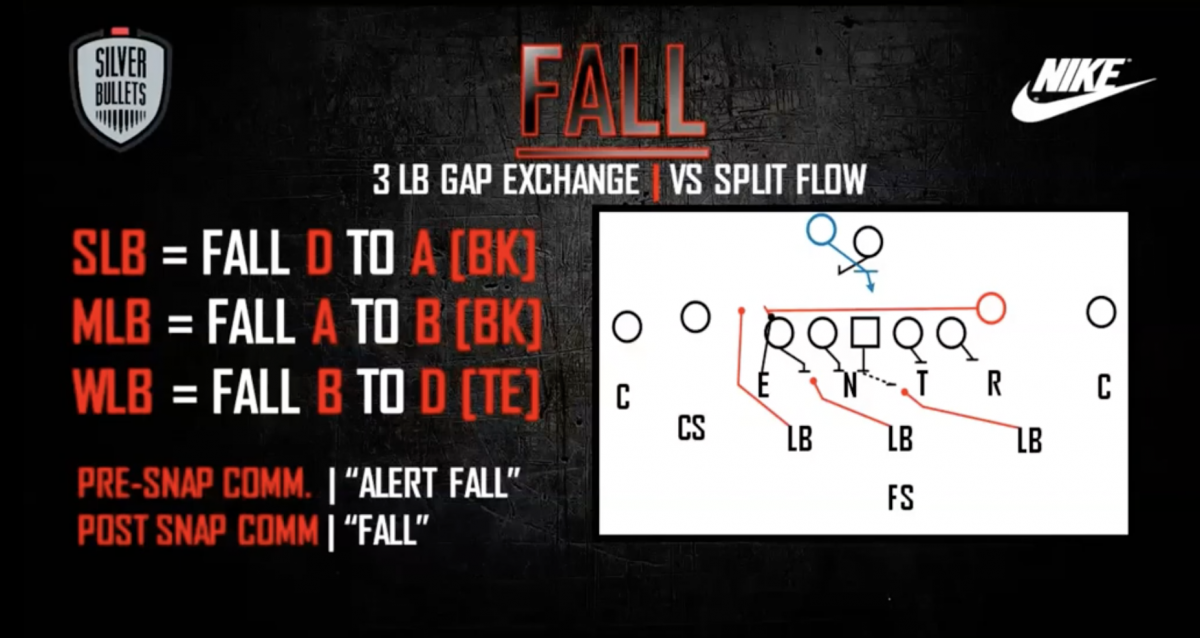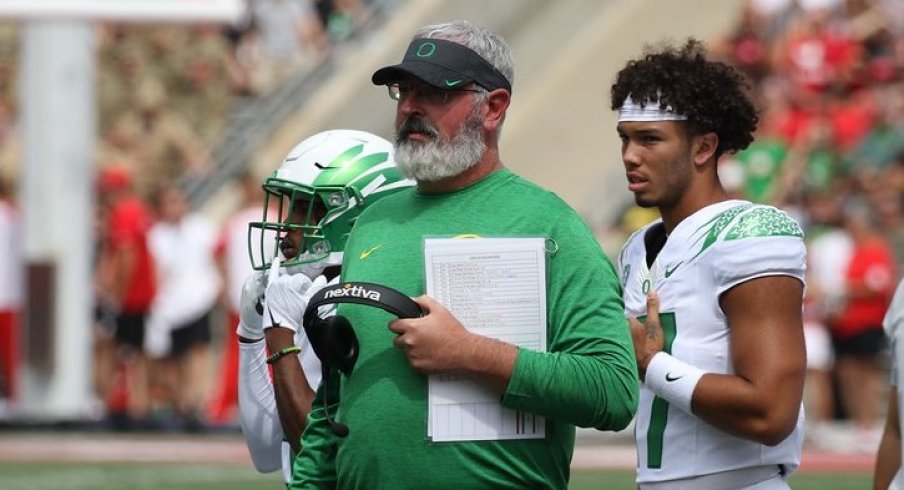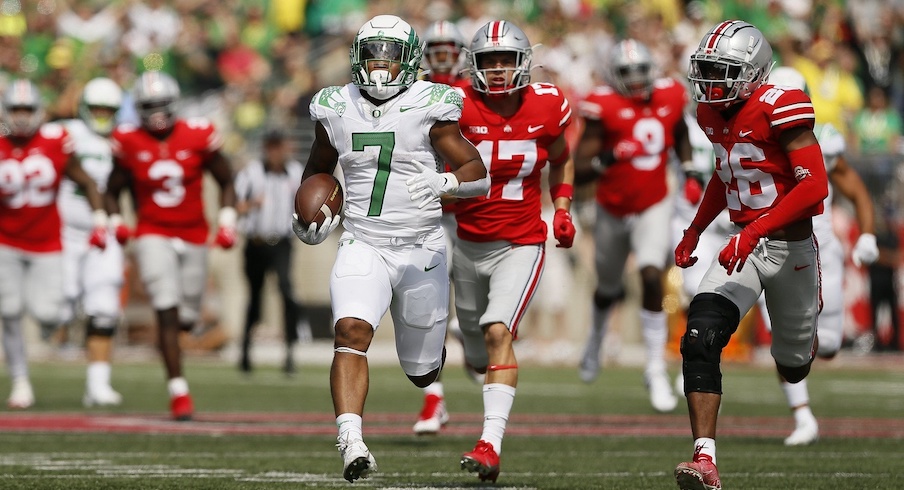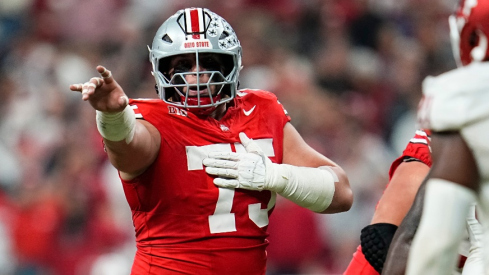Kerry Coombs was officially named Ohio State's defensive coordinator on January 20th, 2020. The very next day, Joe Moorhead was handed the keys to Oregon's offense, meaning means Coombs had exactly 599 days to prepare for what happened last Saturday in Ohio Stadium.
There is a lot to unpack from what 100,000+ fans witnessed in the Horseshoe a couple of days ago, but the takeaway was clear: Ohio State was simply out-coached by its opponent. That can happen from time to time, especially at a program whose assistants are often in high demand elsewhere, but the context behind what allowed Oregon, a two-touchdown underdog, to come away with a 35-28 upset win is important to take into account.
Yes, it was the first time Ryan Day and Mario Cristobal had ever faced off as head coaches, and only Coombs and Larry Johnson were on the OSU staff the last time these programs faced off. But to pretend as though what the Buckeyes saw from the Ducks on offense was unexpected would be misleading.
"I think the amount of plays that were run into the boundary side was something that they probably hadn't shown a good deal of," Coombs told the media after the game.
While Moorhead likely broke some tendencies by directing the action toward the weak side of his formations - a move seen many times from Day and the Buckeye offense with great success - it was by no means a new offense.
Moorhead, as we all recall, made his name by running this very system with Trace McSorley and Saquon Barkley while calling plays for Penn State from 2016-2017. In his last visit to the 'Shoe, his team hung 38 on the home team and were only taken down when J.T. Barrett played the best half of his life.
And in that contest, we saw the same offense that showed up on Saturday in green and gold.
Through the use of formation, motion, and post-snap options, Moorhead absolutely ate up the single-high scheme that everyone in the country knows they're going to get from Ohio State's defense. On one play, Moorhead would ask quarterback Anthony Brown to read an unlocked defensive end, the next an outside linebacker, leaving Buckeye defenders on their heels all afternoon.
“I sometimes refer to our offense as the Chipotle offense. There’s not a ton of ingredients but there’s a ton of mixing and matching going on,” Moorhead said during a 2017 interview. “You have a few things you can hang your hat on and through different tags and RPO aspects, you can change the presentation and make it look like you are doing more than you actually are.”
We saw this philosophy at work on the Ducks' very first possession, pairing a simple swing pass with a QB run inside, making OSU linebackers look like they were wearing concrete shoes.
Nice Design from Oregon
— Coach Dan Casey (@CoachDanCasey) September 11, 2021
Formation Unbalanced
RB Tear Motion
QB Split Zone + RB Swing Screen pic.twitter.com/pAK0mCH7is
Such quick-hitting plays negate the Buckeyes' talented defensive front, as the ball gets spread outside often before they ever have a chance to make a play.
“They were just getting the ball out of their hands fast,” Ohio State defensive tackle Haskell Garrett said afterward. “Nothing really you can do, you just got to close the pocket."
That Split-Zone action, in which the offensive line zone blocks in one direction while the tight end comes back across the formation to seal the backside defender and create a cutback lane, was seen countless times throughout the day, yet the Buckeyes struggled to handle it.
The way linebackers coach Al Washington likes to respond is by making a 'fall' call, in which the linebackers all bump over one gap to accommodate for the tight end's path in the backfield.

Yet, on the Ducks' second drive, which began from their own 1-yard line, we saw a failure to execute this simple concept. While WILL linebacker Teradja Mitchell correctly fills the C-gap, middle linebacker Tommy Eichenberg seems to step forward, directly into the path of the Ducks' double-team of Haskell Garrett.
Instead of getting over the combo-block and taking away the wide-open B-gap, Eichenberg gets swallowed up by the blockers and can't disengage until the runner has picked up eight yards and a first down. These were the kinds of little gaffes that plagued the Buckeyes all game long.
As the game progressed, Moorhead began messing with that split-zone flow to have the tight end bluff his block on the end and release out into the flat to catch a short pass or let the QB keep and run for himself.
The Ducks put on a master class in 'staying ahead of the chains,' meaning they gained positive yards on seemingly every play and had manageable third-down situations. Brown completed just one pass over 20 yards downfield during the game, yet was never really forced to do so, as he was able to pick up small chunks of yardage to keep drives alive.
On the first drive of the second half, Oregon faced a third down, up just one score and holding the ball at just its own 23-yard line. But the Ducks only needed to pick up three yards for a first down, meaning they could run their normal, option-heavy offense instead of needing to call a dropback pass, so Moorhead called the same play as the one seen above.
Upon seeing the tight end flash across the formation, Eichenberg raced outside to follow him in man-coverage while Mitchell 'fell' down to the C-gap, and Zach Harrison played the QB keep as the optioned defender.
But since Eichenberg was so worried about blanketing the tight end in pass coverage, he vacated his role as a run defender, leaving the B-gap wide open for C.J. Verdell to race through on his way to the end zone.
Much has been written about the Buckeyes' run defense, as though it's somehow separate from their ability to stop the pass. Nothing could be further from the truth.
As we see above, the way Ohio State, or any defense for that matter, chooses to defend one element of an offense directly impacts its ability to defend the other. By only running single-high coverage schemes, the Buckeye defense limits the answers it can provide to the schemes seen above.
For instance, one way to handle a tight end releasing like that is to play Cover 2, leaving a defender sitting directly in that zone in case a receiver leaks out. This would allow the middle linebacker to defend an interior run gap while taking away the flat.
But, for whatever reason, the Buckeyes didn't play Cover 2 on Saturday. Or Cover 4. Or Cover 6. Or any other 2-deep coverages one might be able to draw up. Instead, they ran their base, Cover 1 man-coverage with a deep safety or a spot-drop, Cover 3 zone. And Moorhead knew it.
When Oregon did want to throw the ball downfield, they called for concepts that even a junior high school coach knows will beat Cover 3, such as this Flood concept that sent three receivers to one side of the field against just two defenders.
But nothing was more emblematic of the matchup between these two staffs than what we saw in the red zone. The Oregon coaches had done their homework and knew that the Buckeyes rely, almost exclusively, on man-coverage once opponents reach their 20.
As such, the Ducks used a simple crack block from a receiver in a condensed split to wall off the edge for a sweep. With Bullet Ronnie Hickman keeping eyes on the tight end in that spot, he and middle 'backer Cody Simon both get taken out of the play, allowing Verdell to waltz around the end for an easy six points.
Two drives later, the Ducks were back in the red zone, facing 4th & 1 at the OSU 14. This time, Moorhead called for not one, but two crack blocks from his tight ends on the edge, pitching the ball out to Verdell for what was technically a pass but was in all senses a classic, toss sweep with two pulling linemen.
This time, an entirely new crew of linebackers collided with each other, taking each other out of the play as SAM 'backer Palaie Gaoteote had his eyes on the tight end in man-coverage before picking off his teammate, Eichenberg.
One would expect Ohio State's defensive staff to make some sort of adjustment to this action at halftime, but if they did, it certainly wasn't apparent. As the Ducks reached the red zone early in the third quarter, Moorhead went back to the crack sweep yet again.
This time, however, the tight end was replaced by a wide receiver, meaning it was a cornerback over the crack block instead of the Bullet. If Coombs and his staff had instructed members of the defense in this instance to 'crack and replace' (akin to making a 'switch' call on the basketball court when your man sets a pick on one of your teammates), that message didn't make it to Lejond Cavasos.
“The perimeter run play where we didn’t get the crack, that showed up a couple times,” Day said after the game. “So if they hit you with it once, that’s not good, but you want to get it fixed. If they hit you with it twice, then there’s an issue that needs to be fixed. So we need to look at that and figure out what it is.”
Following the game, Coombs was grilled by reporters asking if the scheme itself was to blame.
"The defensive structure that has been in place is one that has been successful and one that people feel comfortable with," the coach responded.
On that account, he is correct. This reliance on a single-high scheme has found success, not only at Ohio State but in the NFL. But the system's highest points have come when it's being executed by elite talent.
Pete Carroll is credited with making this approach successful with his 'Legion of Boom' defense in Seattle, but even he has struggled to succeed consistently without the best free safety in football or a duo of shutdown corners. As a result, the Seahawks employ two-deep coverages nearly 1/3 of the time these days.
Similarly, without Chase Young, Jordan Fuller, and a couple of first-round picks manning the outside, this version of the Buckeye defense hasn't been as successful as it was in 2019 when it debuted. Yet we have not seen any change-ups as opposing play-callers have carved up this system in two of Ohio State's last three games.
Perhaps more alarming than the lack of schematic diversity, however, was the manner in which the Buckeyes looked unprepared for Moorhead's offense. There's more than one way to defend the option, and playing man-coverage is far from the worst approach.
In fact, many coaches - Nick Saban included - will rely on Cover 1 in the tensest situations. But every coverage requires repetition against specific looks in order to succeed.
One major reason the Buckeyes finally began getting some stops late in the game was that Moorhead had run out of tricks and began calling the same plays for the fourth or fifth time, and only then had the OSU defenders begun to recognize what was coming their way. But that raises the question of why hadn't the players seen them before? Why did it take three quarters and 35 points surrendered to get to that point?
While Oregon certainly has plenty of resources thanks to the philanthropic attitude of its most famous alum, Nike founder Phil Knight, it's not as though Ohio State is outmatched in this department. The Buckeyes have as large a football operation as any program in the country.
There is a small army of analysts, graduate assistants, interns, and quality-control coaches working inside the Woody Hayes Athletic Center, all employed to help the players adequately prepare for a game that has been years in the making. This game was the most-anticipated on both team's schedules in each of the past two seasons, yet it seems only one of them was ready for it.
“I don’t think there’s any question that we have to do things differently going forward,” Coombs said after the game. “Obviously the result today is not acceptable, and so we have to do things differently.”
- #3 Ohio State 28, #12 Oregon 35
- • Ohio State falls to Oregon in home opener
- • run defense doomed Ohio state as defense struggles persist
- • ohio state had three 100-yard receivers for the first time ever
- • despite the loss, ohio state's goals are still achievable
- • OHIO STATE POSTGAME • Notebook • quotebook
- • PHOTOS • five things • debriefing • three key stats • social reax




